An ecommerce online marketplace is a digital platform connecting multiple third-party sellers with potential buyers, facilitating the buying/selling of a wide range of products or services. These marketplaces serve as intermediaries, allowing various independent sellers or businesses to list and sell their products or services to a larger audience of online shoppers.
While there are many ecommerce online marketplaces, only a few cater to sellers looking to sell handmade and one-of-a-kind products. Etsy is one of the most fascinating examples of global handicraft business creation.
For 18 years, Etsy has been a platform to sell products like sculptures and handwritten recipes. In general, it is an ecommerce website that focuses on selling handmade or vintage goods from individuals.
In this article, we will determine how to create a website like Etsy. You will learn how this two-sided ecommerce online marketplace works and how it makes money. Moreover, you will find out how much it costs to create a platform similar to Etsy and which core features it should have.
Etsy: an overview of the global online marketplace
The Etsy project was started in 2005. Today, it is a vast online marketplace development solution with over 7.5 million active sellers and over 100 million products. The site allows sellers to equip their own "shops" and sell directly.
What can buyers look for on Etsy's website? Everything! It is about unique designer things, creative gifts, vintage items that customers will find all here.
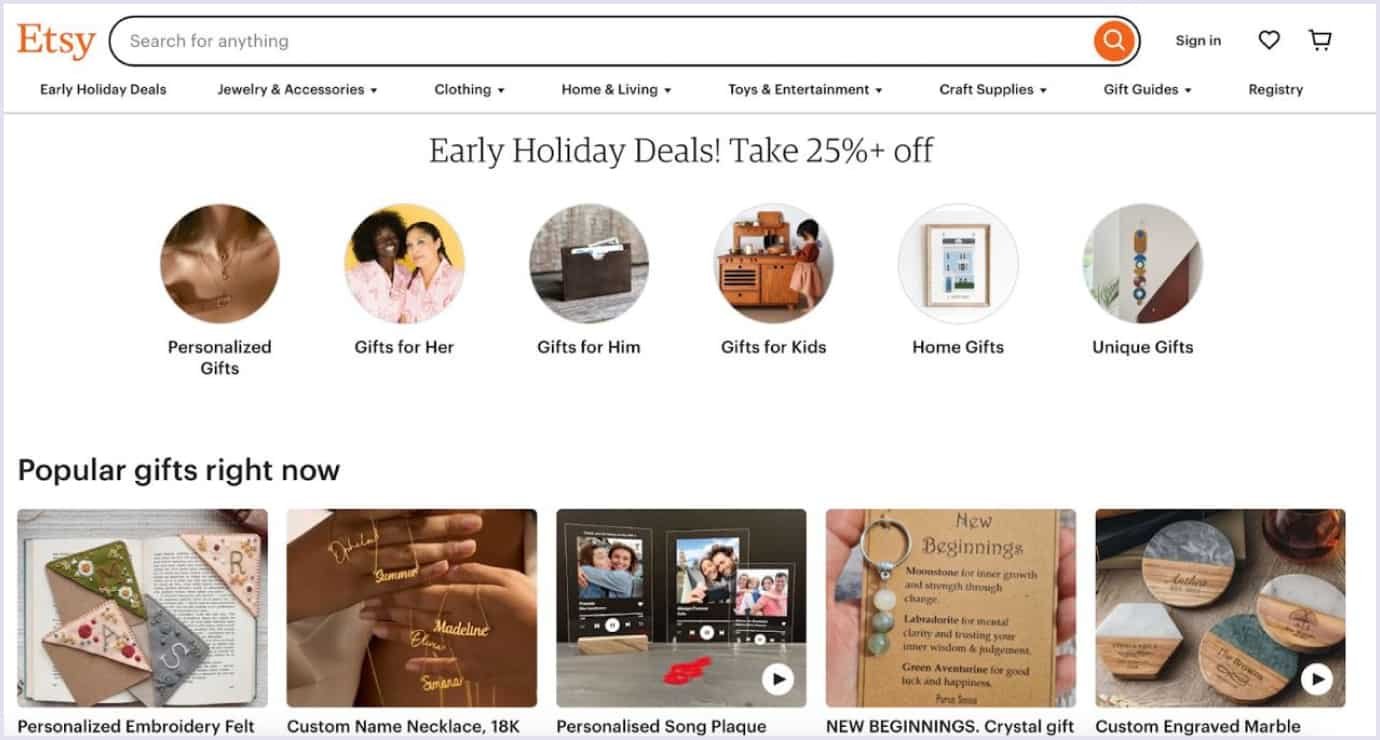
Etsy: how it started
The idea of the ecommerce marketplace solution launching belongs to the artist and photographer Rob Kalin. In general, Kalin says the idea of developing the Etsy online marketplace came to his mind when he realized there was no appropriate site for selling handmade goods.
The businessman's partners were his two friends, Chris Maguire and Haim Schoppik. The originality of the idea and the presence of a free niche led the friends to set about implementing the project. None of them was an expert in web development, but everyone was fond of creativity and wanted to improve the world.
Three months later, a platform prototype received the name Etsy and was ready. Kalin said the online marketplace received such a name because it sounds excellent, and it is convenient to build a brand with unique features around such an original word. Interestingly, “Etsy” comes from the Italian “eh, si,” meaning “oh, yes.”
Gradually, the service increased the target audience and attracted sellers significantly. In July 2007, the millionth sale was made on the Etsy handmade marketplace. And in November of the same year, more than 300,000 purchases worth over $4.3 million were made on the marketplace.
The high growth rate of the service's audience soon attracted the attention of venture capital funds. So, in January 2008, Etsy received a $27 million investment.
Nowadays, Etsy is a super-successful ecommerce company, and many wonder how to create an online marketplace like Etsy. Interestingly, this selling platform has benefited from the COVID-19 pandemic. People stayed at home, and “furniture has become the top-selling category during the pandemic,” Etsy CEO Josh Silverman told CNBC’s Mad Money.
Key Etsy facts
If you are wondering how to create a website like Etsy, let's quickly look at the key Etsy facts.
- Founder: Rob Kalin, Haim Schoppik, Chris Maguire, and Jared Tarbell
- Year founded: 2005
- Funding received: a total of $97.3 million in 9 rounds
- Number of buyers: over 95.1 million active buyers
- Number of sellers: over 7.5 million active sellers
- Number of employees: 2790 employees (as of December 30, 2022)
- Etsy’s competitors: eBay, ArtFire, Aftcra, Ruby Lane
Etsy’s payment gateways
There are dozens of gateway providers. However, the Etsy marketplace cooperates with such licensed providers as:
- PayPal
- Apple Pay
- Google Pay
- Klarna
- iDeal
Besides, users of the Etsy marketplace can pay by credit cards, debit, bank cards, Etsy Gift Card, Etsy Credits, etc.
Read also: 9 Best Payment Solutions for Online Marketplaces in 2023
Etsy's marketplace battles
In this ever-evolving ecommerce landscape, Etsy doesn't stand alone. To gain a comprehensive perspective on its competitive landscape, let's delve into the world of its analogs, challengers, and like-minded platforms.
eBay
A household name in ecommerce, eBay predates Etsy and offers a broad range of products. It's a diverse marketplace where new and used items are bought and sold, catering to various consumer preferences.
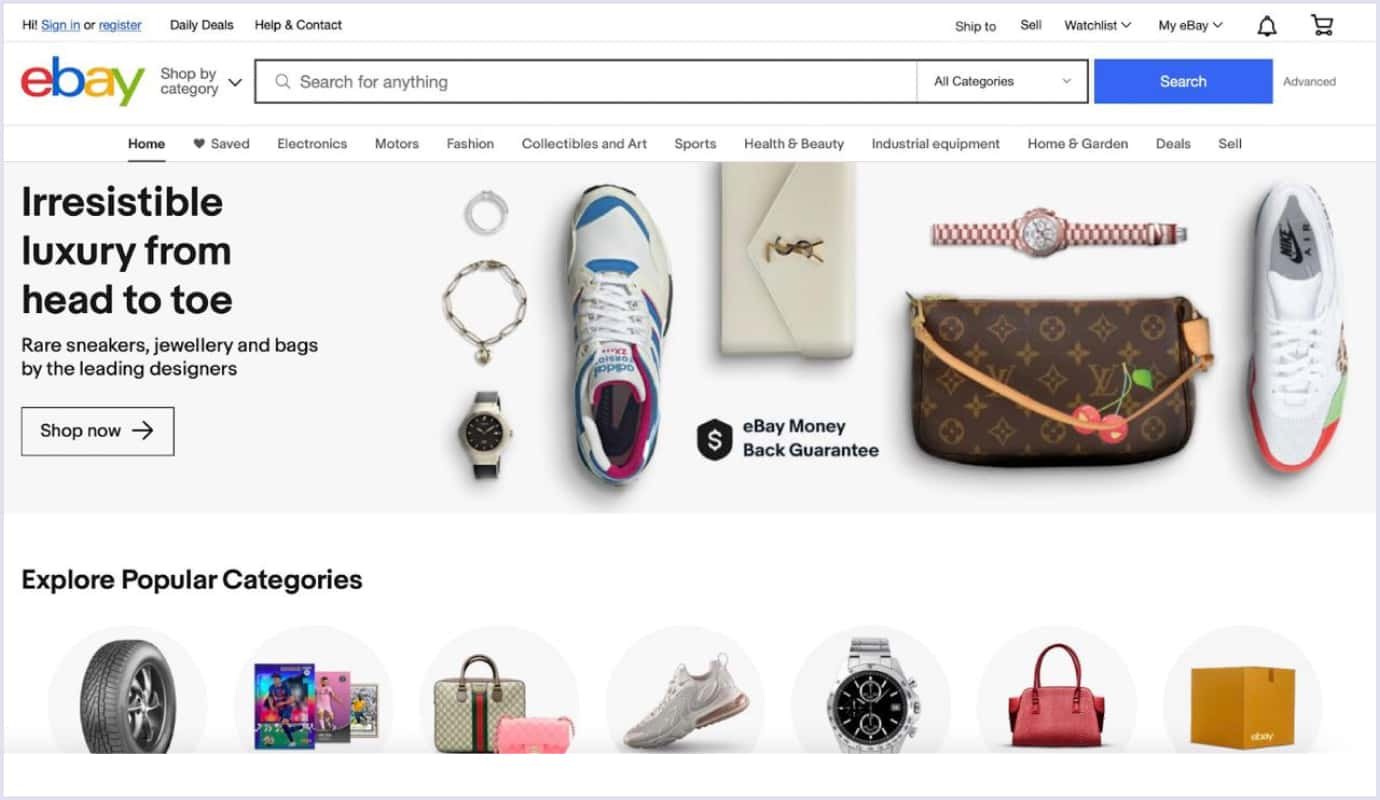
Amazon
A global giant, Amazon, extended its reach to the handmade niche with Amazon Handmade. While it competes with Etsy in some areas, it offers different features and a vast customer base.
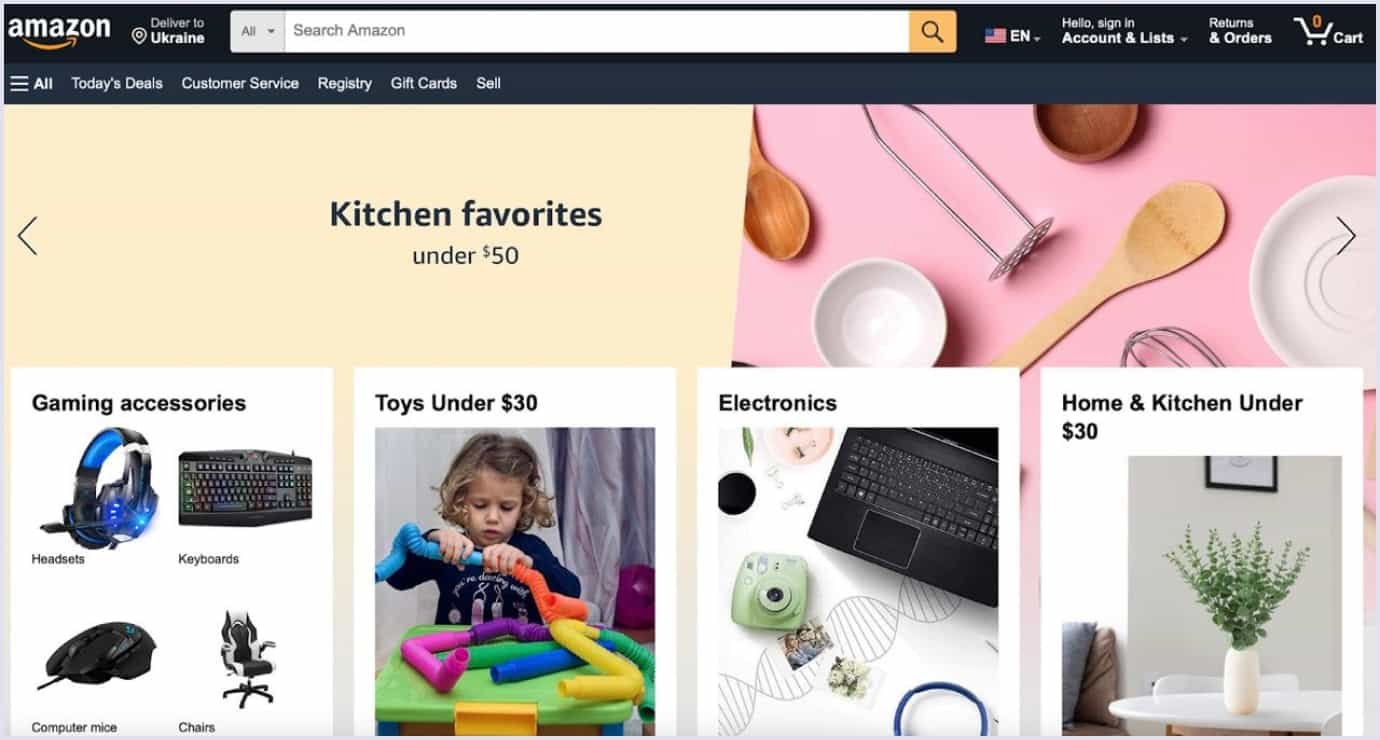
eCrater
It offers a free online marketplace platform where sellers can list products and have them integrated into a standalone online store. It's a budget-friendly choice for small businesses and amateurs.
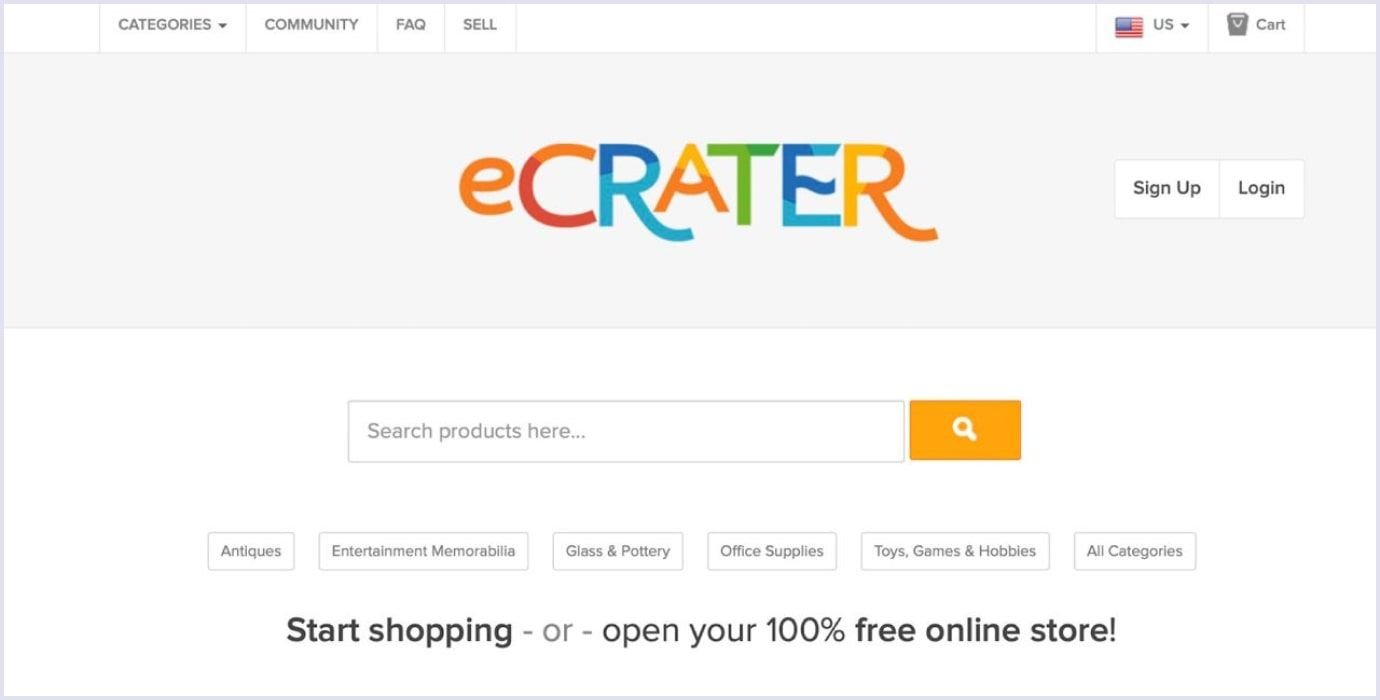
Comparing the key elements: what sets them apart
Now, it is crucial to understand the unique features and offerings of these prominent platforms.
| Aspect | Etsy | eBay | Amazon Handmade | eCrater |
| Product categories | Handmade, vintage, unique items | New and used items in various categories | Handmade and artisanal products with Amazon's customer base | Platform for listing products and integrating into standalone online stores |
| Community and support | Supportive seller community | Offers a different sense of community and support | Benefits from Amazon's solid customer base | Provides budget-friendly options for creating online stores |
| Listing fees & pricing | Listing fees and transaction fees | Listing fees and final value fees upon sale | Referral fee structure based on item category | No listing or transaction fees |
| Reach & global presence | Global presence, connecting buyers and sellers worldwide | International reach and recognition | Leverages Amazon's extensive reach | Online marketplace open to many sellers and buyers |
So, each platform has its unique value proposition, serving the diverse needs of creators, collectors, and shoppers. The world of ecommerce analogs to Etsy has something for everyone. The choices are great, and the fierce competition drives innovation and diversity in the online marketplace.
Read also: An Online Marketplace Marketing Strategy That Works in 2023
Features of P2P (peer-to-peer) marketplace like Etsy
The renowned online marketplace for handmade and unique products - Etsy - has become a global idol of independent entrepreneurship and artisanal craftsmanship. Its success is not solely attributed to its vast and diverse product offerings but also to the carefully curated and thoughtfully designed core features that support its user-friendly interface.
So, let's uncover what has made Etsy a household name in the world of ecommerce.
Etsy’s features for customers (buyers)
Product listings and details
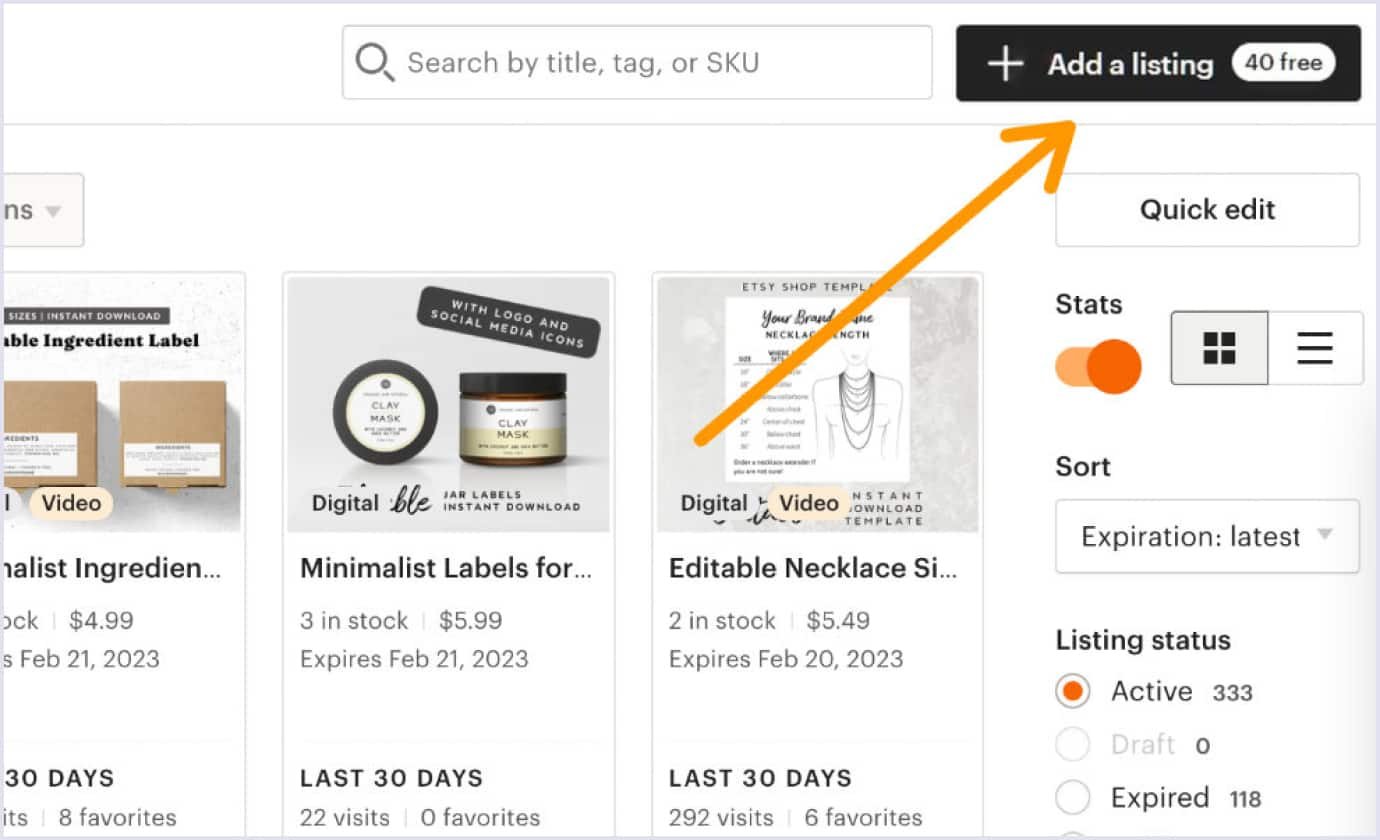
- Rich product descriptions: sellers can create detailed listings, including high-quality images, product descriptions, pricing, and product attributes. The freedom to provide extensive details allows buyers to make informed choices.
- Variations: for items with multiple options (e.g., sizes or colors), sellers can create variations within a single listing, simplifying the shopping experience.
- Customization options: some listings offer customization, allowing buyers to personalize their purchases according to their preferences.
Product categories
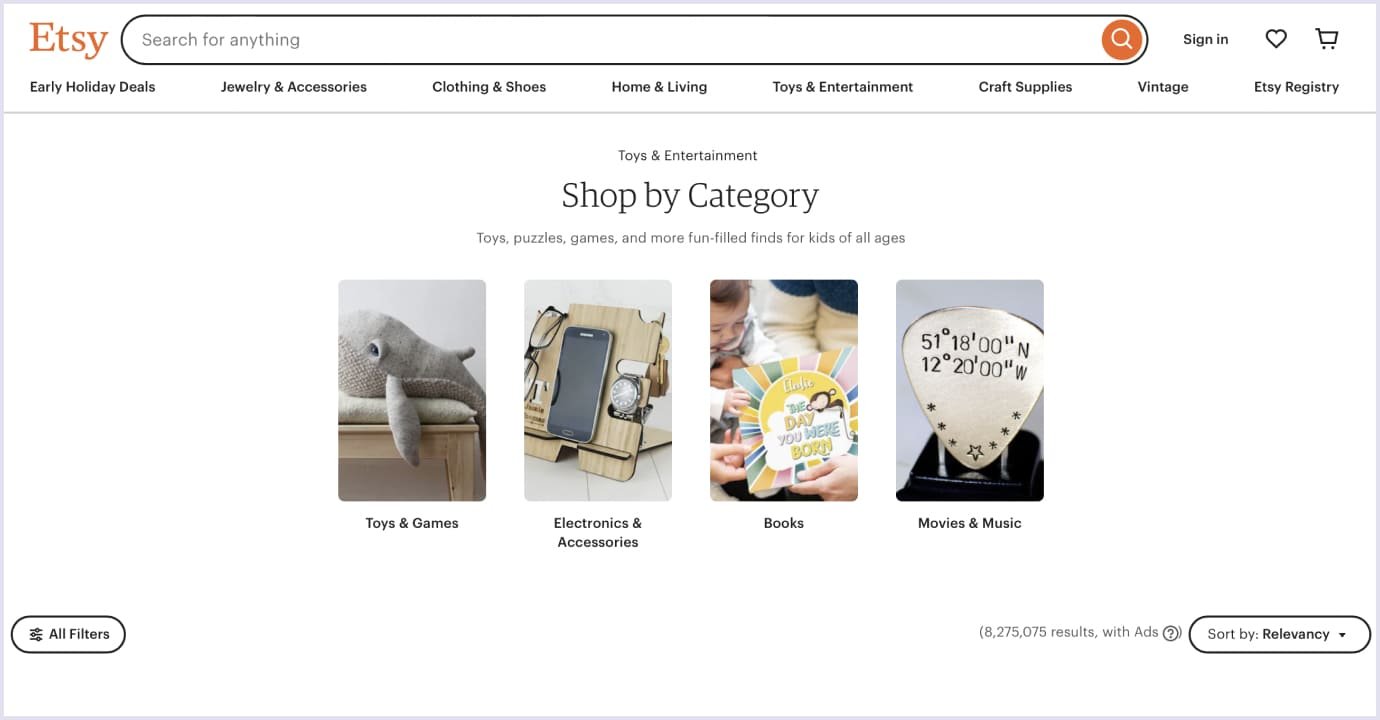
- Structured organization: products are categorized into various sections and categories, making it easy for buyers to navigate and discover items of interest.
- Search filters: buyers can filter search results by price, location, and item specifics, streamlining the product discovery process.
User reviews and ratings
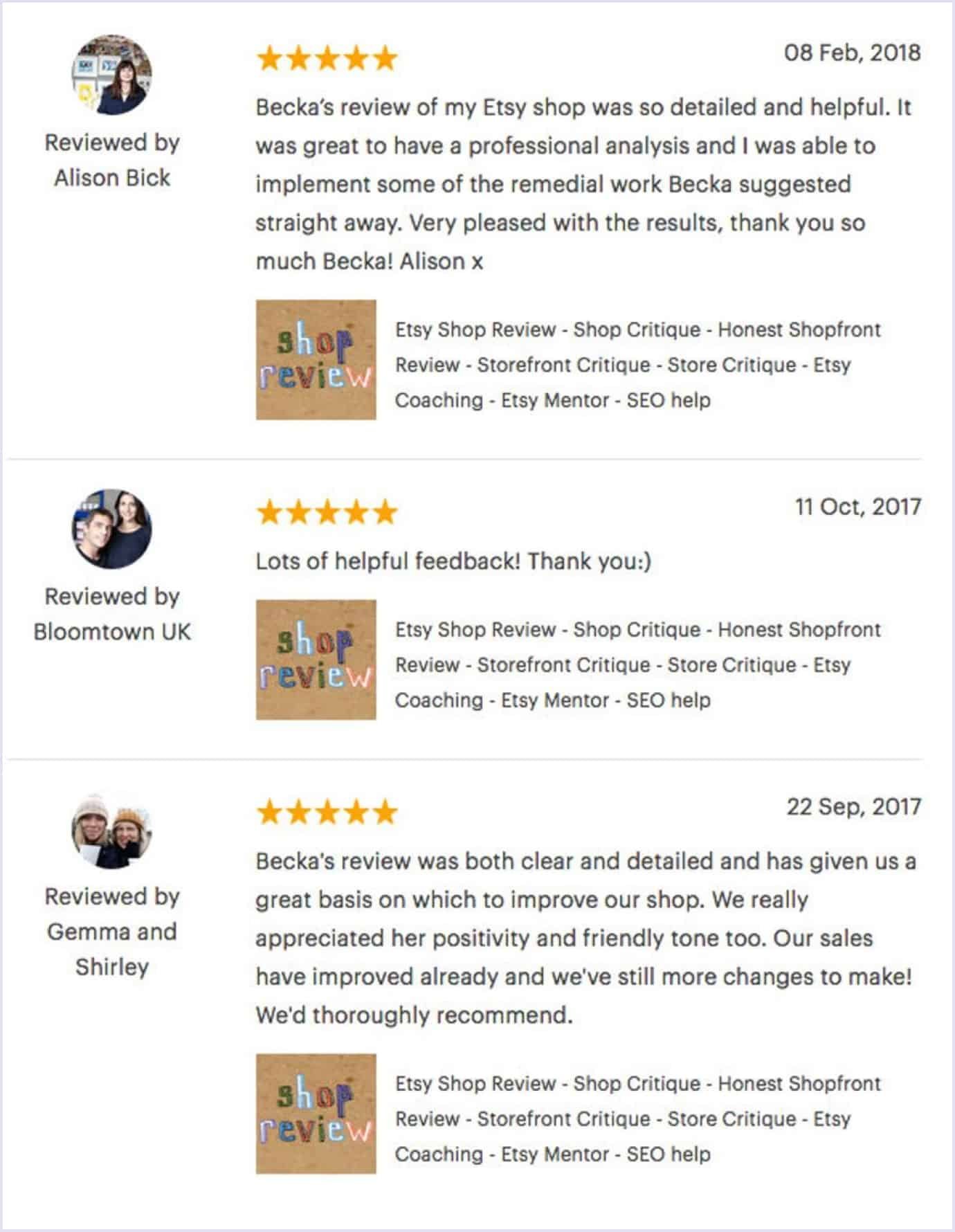
- Transparent feedback: users can leave reviews and rate products and sellers, enhancing transparency and trust.
Conversations and messaging
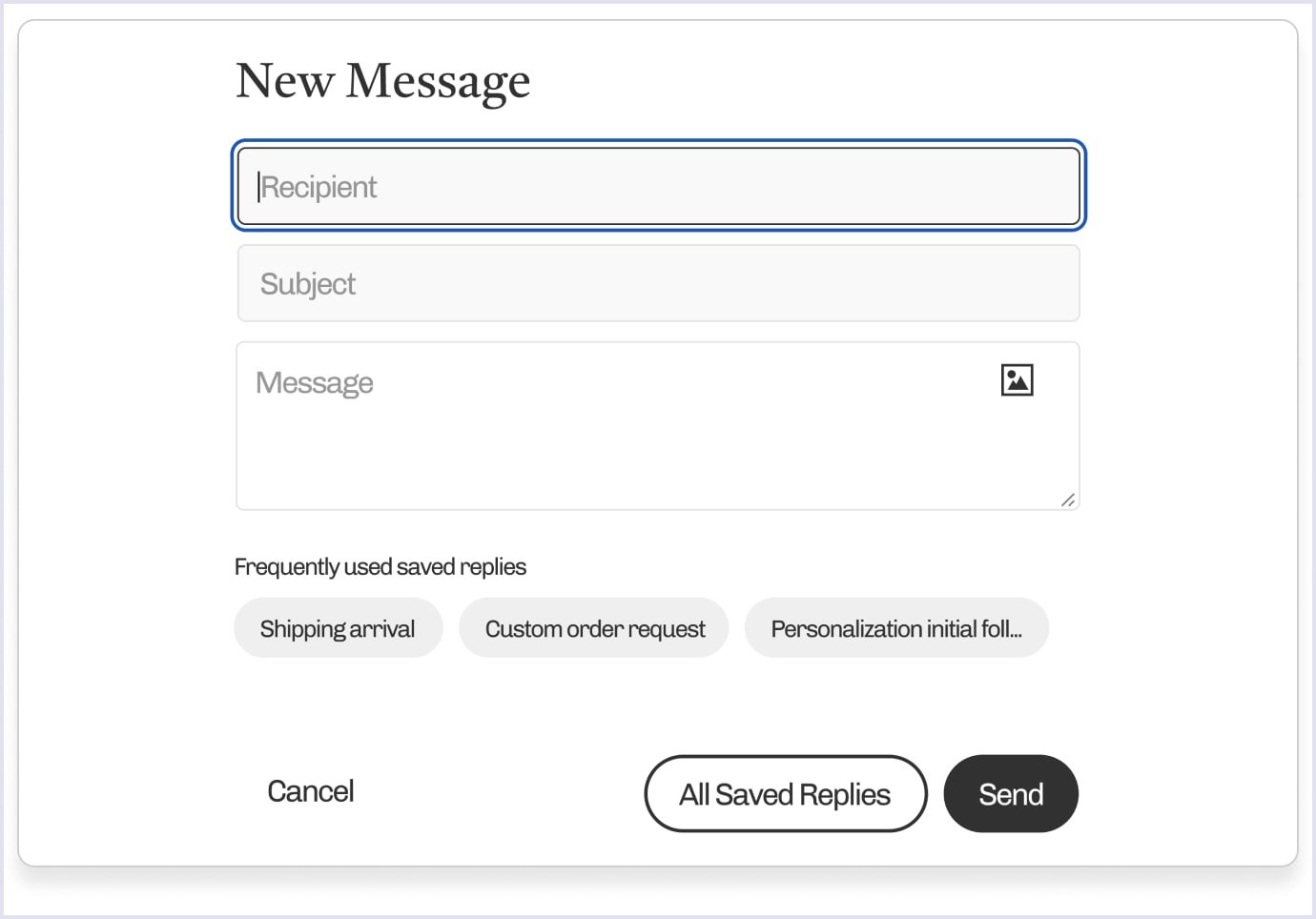
- Direct communication: buyers and sellers can directly message each other to discuss orders, ask questions, and clarify details.
- Order updates: sellers can inform buyers of order updates and shipping information through the messaging system.
Shopping cart and checkout
- Cart management: buyers can add items to their shopping carts and proceed to checkout seamlessly.
- Payment options: Etsy integrates with various payment gateways, ensuring secure transactions. This includes credit cards, PayPal, and Etsy's payment system.
Mobile responsiveness
- Optimized mobile experience: Etsy offers a responsive design, providing a seamless shopping experience on mobile devices, which is crucial in an era of mobile ecommerce.
Social sharing and integration
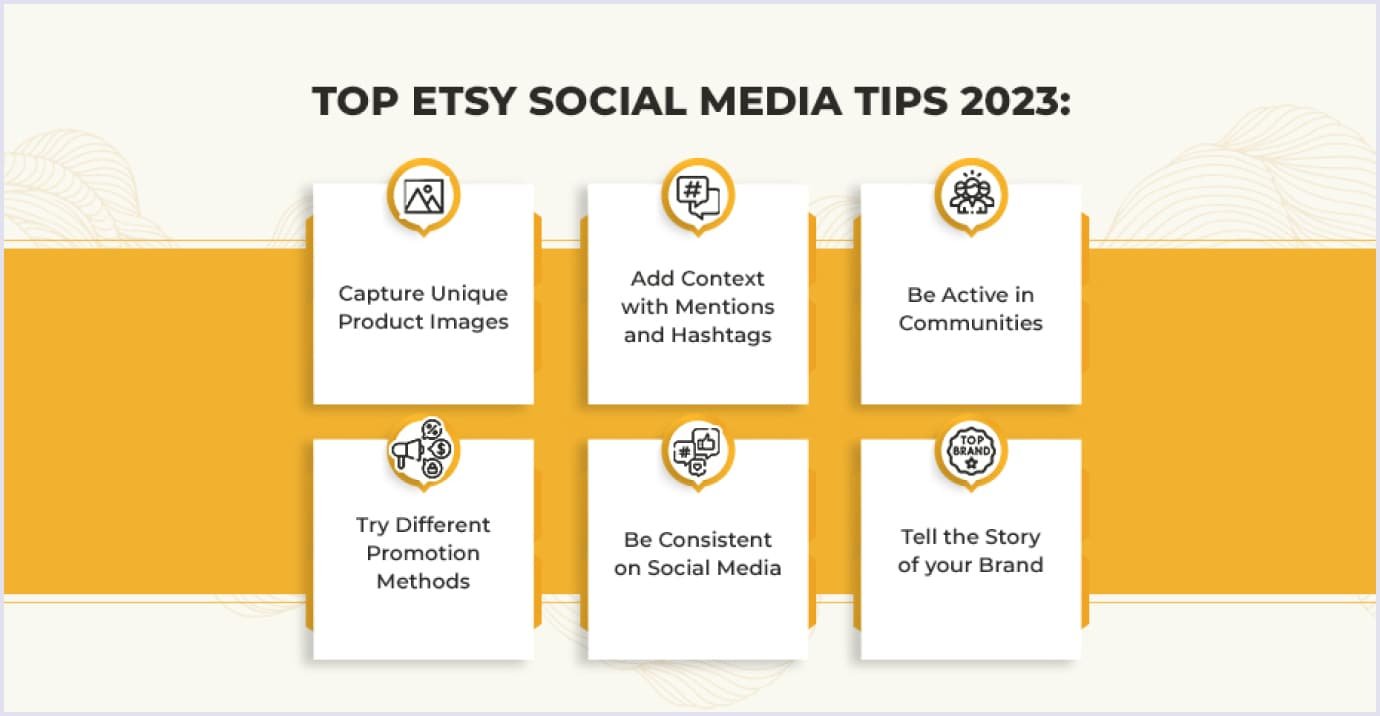
- Social media sharing: products, shops, and favorites can be shared on social media platforms, boosting exposure.
Etsy’s features for sellers
Product listings and details
- Detailed product descriptions: sellers can create detailed listings, including high-quality images, product descriptions, pricing, and product attributes.
- Variations: sellers can create variations for items with multiple options to simplify the shopping experience.
- Customization options: some listings offer customization, allowing sellers to offer personalized products.
Seller profiles
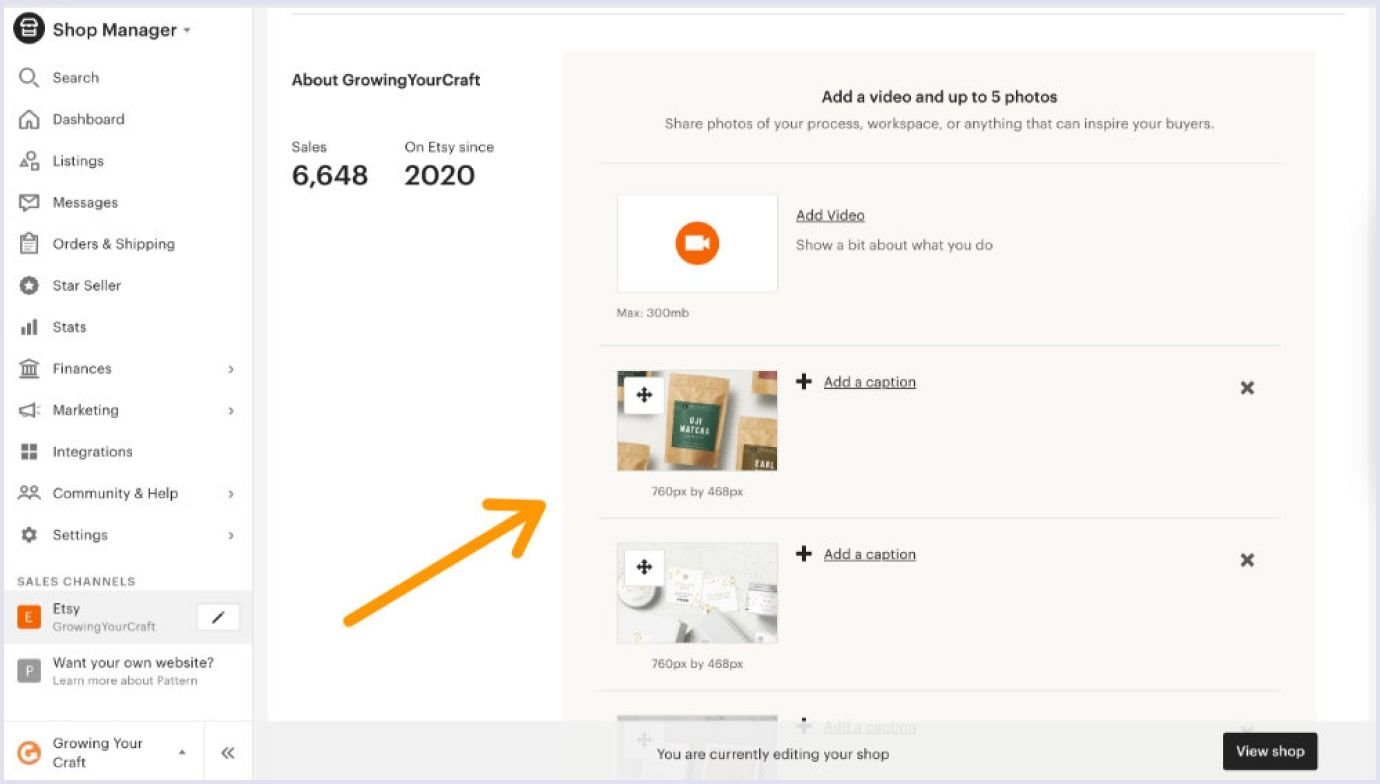
- Shop customization: sellers can customize their shop profiles with banners, logos, and a distinct brand identity.
- Seller information: seller profiles provide information about the creator, their inspiration, and shop policies, adding a personal touch to the shopping experience.
User reviews and ratings
- Transparent feedback: sellers receive reviews and ratings from customers, contributing to their reputation in the marketplace.
Conversations and messaging
- Direct communication: sellers can communicate directly with buyers to discuss orders, answer questions, and provide order updates.
Shopping cart and checkout
- Cart management: sellers can manage and process orders from the shopping cart.
- Payment options: sellers can use Etsy's integrated payment system, along with options like credit cards and PayPal, for secure transactions.
Sales and promotions

- Coupon codes: sellers can create coupon codes to offer discounts to customers, encouraging repeat purchases.
- Promoted listings: sellers can pay to have their products featured prominently in search results and category pages to enhance visibility.
Social sharing and integration
- Social media sharing: sellers can share their products and shops on social media platforms for increased exposure.
- Integration with Facebook and Pinterest: Etsy integrates with Facebook and Pinterest for streamlined sharing and marketing.
Legal and compliance
- Terms of service: sellers must adhere to Etsy's terms of service, ensuring legal compliance.
- Privacy policies: Etsy's privacy policies explain how user data is collected, used, and protected, helping sellers maintain user trust.
Etsy's fundamental features have been meticulously designed and continuously refined to create a unique, user-centric ecommerce platform that offers a delightful shopping experience to buyers. With these basic features, Etsy has fostered a successful community and set a high standard for P2P marketplaces. Whether you want to build your marketplace, these essential features provide a blueprint for creating a vibrant and user-friendly ecommerce ecosystem.
You may also like: What is a P2P marketplace? Key steps for building P2P marketplace software
Monetization strategies for platforms like Etsy
Etsy's business model is similar to other online marketplaces like eBay and Amazon. It is a two-sided P2P (peer-to-peer) marketplace for selling and buying precise, unique, and creative items.
What sets Etsy apart from the rest of the platforms? It is the vertical approach to Etsy’s business model. In general, the marketplace focuses on selling crafts in particular categories. For example, these can be unique handcrafted items or vintage treasures. To compare, Amazon-like sites have a horizontal business model where almost everything is for sale.
Etsy does not charge buyers fees for using the platform. Buyers can browse and shop on Etsy without incurring additional charges beyond the purchase price of their chosen items. Etsy's monetization strategies are focused on the seller side of the platform, allowing sellers to list and sell their products while Etsy collects fees based on their sales and services.
Now, let's discuss details of how you can monetize the marketplace similar to Etsy and how this P2P platform does it.
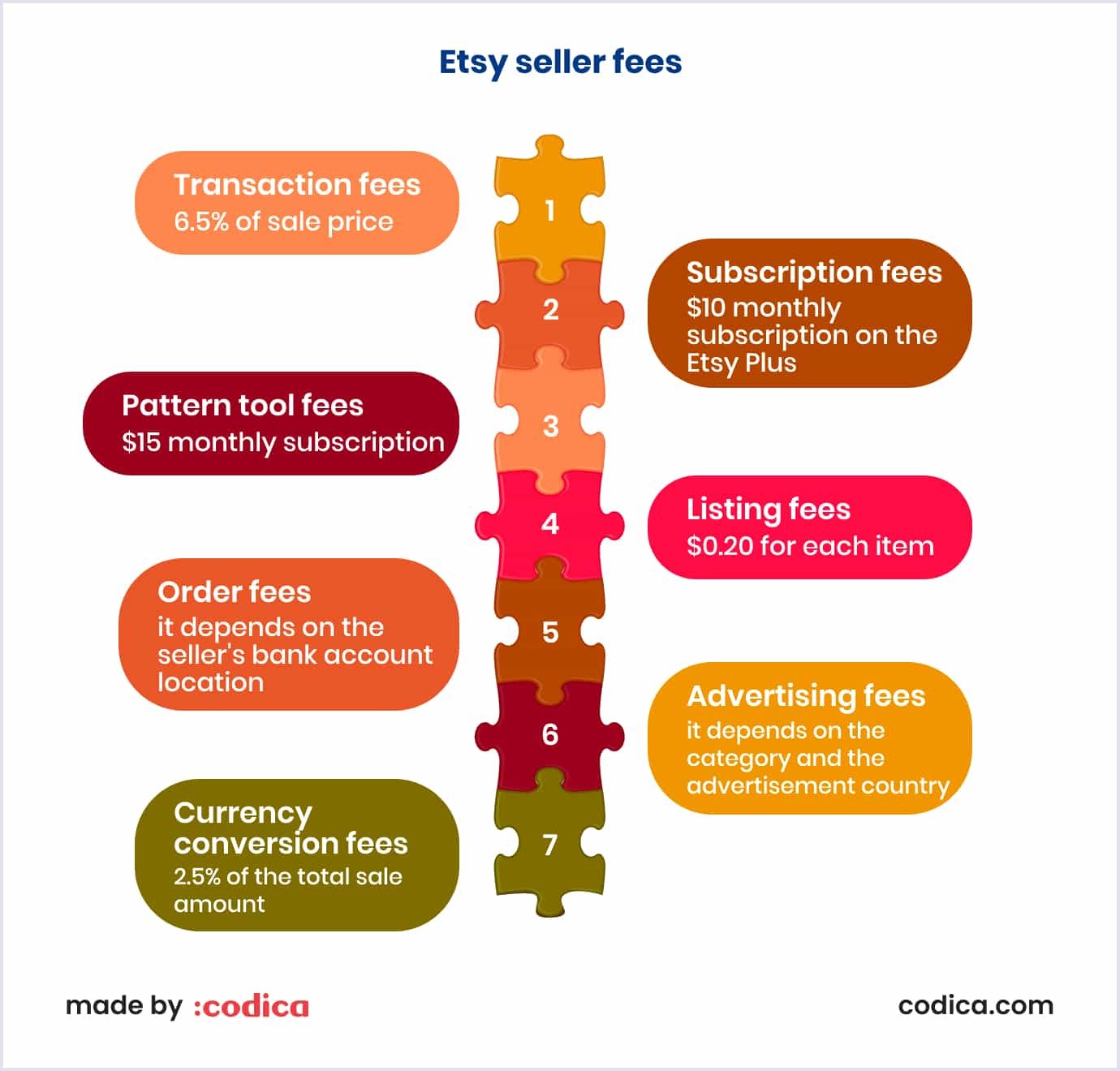
Transaction fees
One of the fundamental ways Etsy generates revenue is through transaction fees. When a seller successfully sells on Etsy, the platform charges a transaction fee. Etsy charges sellers a transaction fee of 6.5 percent of the price for every prosperous sale through its platform. This fee structure ensures that Etsy benefits directly from the wins of its sellers. It's a win-win approach that aligns the interests of both the platform and its sellers.

Subscription fees
Subscription-based models are a common monetization method for online marketplaces. Often, sellers on websites like Etsy.com can sign up for a package that offers multiple additional tools to boost sales. These can be advanced shop customization or access to discounts. For example, the Etsy marketplace charges a monthly subscription on the Etsy Plus package fee of $10. This subscription model provides sellers with additional resources to grow their businesses while creating a steady source of monthly revenue for Etsy.
Pattern tool fees
Pattern is a website builder tool by the Etsy marketplace intended for its sellers. It enables merchants to build online shops on domains independent of Etsy’s platform. The first thirty days of Pattern’s use are free. Then, Etsy charges a monthly subscription fee of $15. This tool fee provides sellers with a valuable service and contributes to Etsy's monetization efforts.
Listing fees
Another way Etsy generates revenue is through listing fees. Etsy charges vendors at least $0.20 for each item they list on the platform. Nevertheless, that’s a profitable revenue model for a marketplace like Etsy. Why? While this fee may seem minor, it becomes a profitable revenue source for Etsy due to the volume of products listed daily on the platform. With thousands of unique and handcrafted items listed regularly, the cumulative effect of these listing fees is substantial.
Order fees
Also, Etsy monetizes its marketplace through charges via the processing of payments. The total fee amount per order varies depending on the seller's bank account location. While the exact fee structure may differ, it represents an additional source of income for Etsy. Payment processing fees ensure secure and reliable transactions for buyers and sellers.
Advertising fees
Usually, online shops like Etsy offer various promotional services to help their vendors increase sales. The advertisements are charged through a cost-per-click (CPC) approach. Notably, CPC rates differ depending on the category and the advertisement country, ensuring that Etsy optimizes its advertising revenue while assisting sellers in reaching their target audience.
Currency conversion fees
It is also a popular revenue model for websites similar to Etsy, especially when dealing with international transactions. For instance, when converting the currency, Etsy charges 2.5 percent of the total sale amount. This fee ensures Etsy maintains favorable exchange rates while generating additional revenue from cross-border sales.
So, we have discussed what types of monetization strategies websites like Etsy can use. Etsy, a popular marketplace for unique and handcrafted goods, employs various monetization techniques to generate revenue while offering a platform for creative entrepreneurs. However, depending on the niche, there can be other methods of fee-charging.

Step-by-step guide to creating P2P ecommerce websites similar to Etsy
Building a peer-to-peer ecommerce website like Etsy is a challenging but rewarding experience. Success will depend on your ability to create a supportive community, provide a platform that's easy to use, and continually adapt to the evolving needs of your users. Now, let’s see what aspects you must consider when building a marketplace like Etsy.
Step 1. Define your niche and audience
Obviously, the most essential rule of commerce is to offer people what they need. Without any doubt, the demand for goods characterizes a successful marketplace. It is vital to guide the niche well, comprehend trends, analyze influencers and direct/indirect competitors, and monitor benchmarks.
On the other hand, Statista research showed that the main reason for startup failure is a lack of financing, with nearly half percent of the startups giving this as the main reason for their business failure.
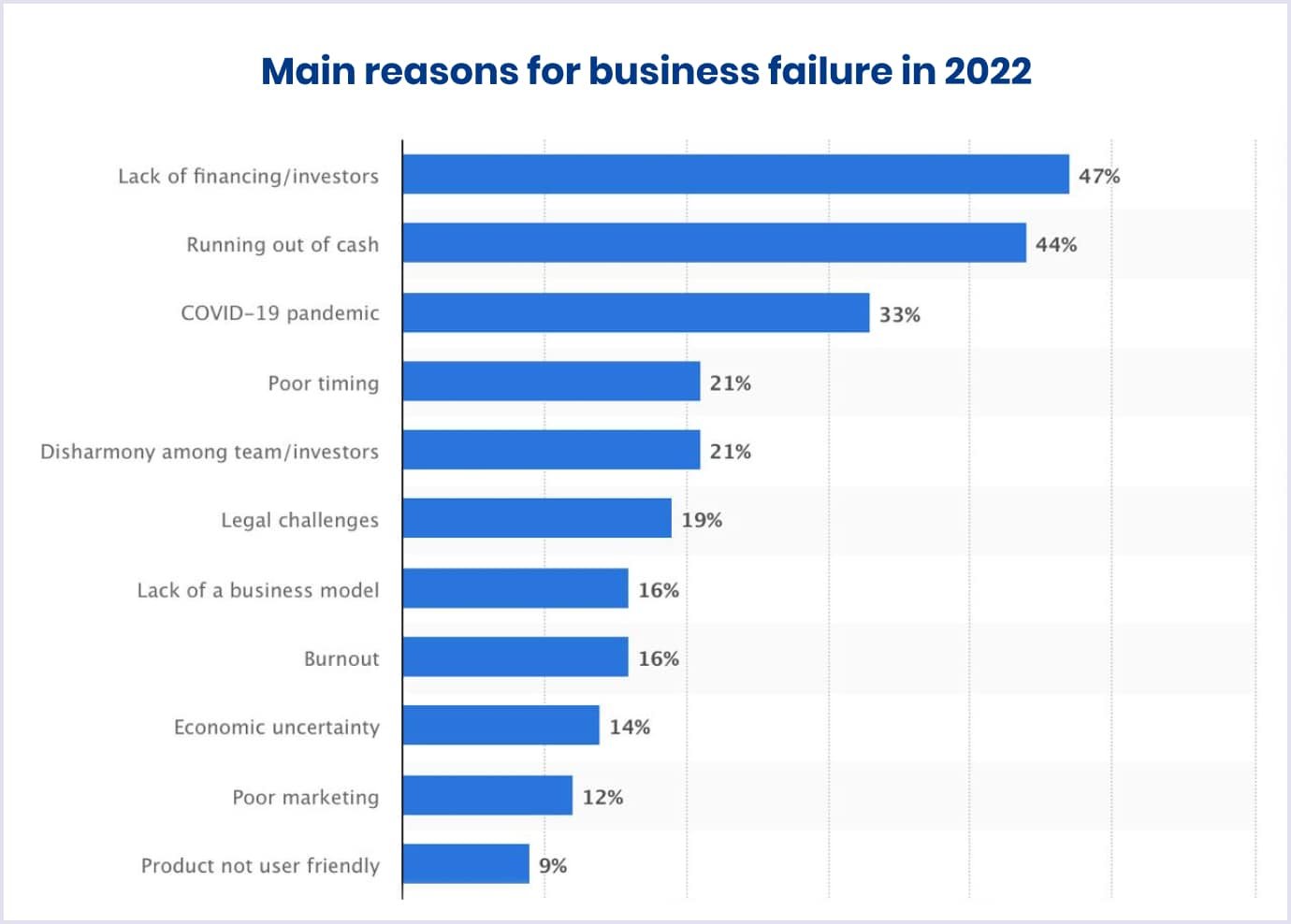
If the niche in which you are going to work is overcrowded, you need to think about how you can interest buyers. Maybe your future Etsy-like site requires some unique ecommerce features. Also, it would help if you stood out from the competition with your peer-to-peer marketplace.
Step 2. Solve the chicken-and-egg problem
The crux of the problem is that no one will make a purchase without sellers. And without goods or services to buy, there will be no buyers. So, to develop your marketplace, you should attract both sellers and buyers to come to your website.
Do you know how the Etsy online marketplace fixed the chicken-and-egg problem? At the initial stage, Rob Kalin and his team faced the question: how to find people who will sell their handmade goods on their site?
Interestingly, the solution was to go beyond the World Wide Web.
Etsy representatives began to regularly visit various arts and crafts exhibitions in the US and Canada. At that time, the anti-consumer movement was gaining popularity. So, the number of various fairs where you could buy or sell handmade things grew by leaps and bounds.
This anti-consumer movement was characterized by a heightened awareness of the environmental impact of mass production and a preference for artisanal, handcrafted goods over mass-produced items. The movement played a pivotal role in shaping Etsy's reputation as a platform that promoted handmade and artisanal items in response to the evolving preferences of consumers.
To put it short, the Etsy team aimed to attract the most influential artists and vintage collectors. The founders believed that their followers would move to the platform after them. So, the followers could be potential customers interested in buying handmade items. Meanwhile, leading artists, artisans, and collectors didn't mind expanding their audience.
Thus, the "recruited" sellers referred their customers to the Etsy site. In such a way, they provided an additional influx of potential buyers.
Certainly, attracting new sellers and buyers is a real challenge for all startups. However, Etsy successfully solved this problem.
Addressing the chicken-and-egg problem in a rapidly evolving digital landscape like 2024 can be a challenging but crucial task for the success of your online marketplace. To overcome this challenge, you can consider several strategies:
- Strategic partnerships. Collaborate with established brands or niche communities relevant to your marketplace. Partnering with influencers who have a robust online presence and a dedicated following can help attract both sellers and buyers. These influencers can promote your platform, encouraging sellers to join and buyers to explore the unique offerings.
- Niche focus. Similar to Etsy's approach, focus on a specific niche or trend that's gaining popularity. Identify a growing movement or interest that aligns with your marketplace's offerings. Tailor your platform to satisfy the unique needs and preferences of this niche, attracting both sellers and buyers who share a common interest.
- In-person engagement. Attend relevant industry events, trade shows, and expos to establish a physical presence. This can help you connect with potential sellers and buyers in the real world. Collect feedback, build relationships, and promote your online platform as a valuable extension of their interests.
- Community building. Create a vibrant online community within your platform. Offer forums, discussion boards, and social features that encourage engagement among both sellers and buyers. A thriving community can foster a sense of belonging and attract more participants.
- Education and resources. Provide educational resources and tools to support sellers in optimizing their listings and sales strategies. By helping sellers succeed, you can attract more of them to your platform, which, in turn, draws more buyers seeking quality products.
- User-centric approach. Continuously gather feedback from sellers and buyers and improve based on their input. By demonstrating that you're responsive to their needs and concerns, you can build trust and encourage user loyalty.
Related reading: 10 Smart Ways to Solve Chicken and Egg Problem for Online Marketplaces
Step 3. Choose a revenue model
We have already discussed what monetization strategies the Etsy marketplace uses. These revenue models are transaction, subscription, listing, advertising, fees per order, and currency conversion fees.
Indeed, you can monetize your Etsy’s clone website in different ways. For example, it is about transaction fees, subscription tiers, listing fees, premium services, advertising and sponsored content, cross-border transaction fees, physical market events, and more.
The main mistake in creating a marketplace is to choose the wrong business strategy and stubbornly develop a product without testing it on a “live” audience. As a result, the marketplace fails because it does not provide the desired value for the consumer. Also, the monetization model may not work. Therefore, efforts, time, and budget will be wasted.
If hypotheses are regularly tested, there is practically no way to make a false step. So, it would be best if you tried to sell the product from the very start with the help of a minimum viable product (MVP).
Notably, employing MVP development services is the best way to determine the audience’s interest. Thus, you will determine its needs and the correct revenue model for startups, including craft websites like Etsy.
You may also like: How to Create a Minimum Viable Product (MVP): Best Examples and Key Benefits
Step 4. Identify the basic functionality
If you are wondering how to create an online marketplace like Etsy, your P2P ecommerce marketplace should include the following features:
Convenient management of pages and goods. Implement user-friendly tools that enable easy management of seller pages and products.
Product catalog. Develop a comprehensive and organized product catalog that allows users to explore and navigate various items seamlessly.
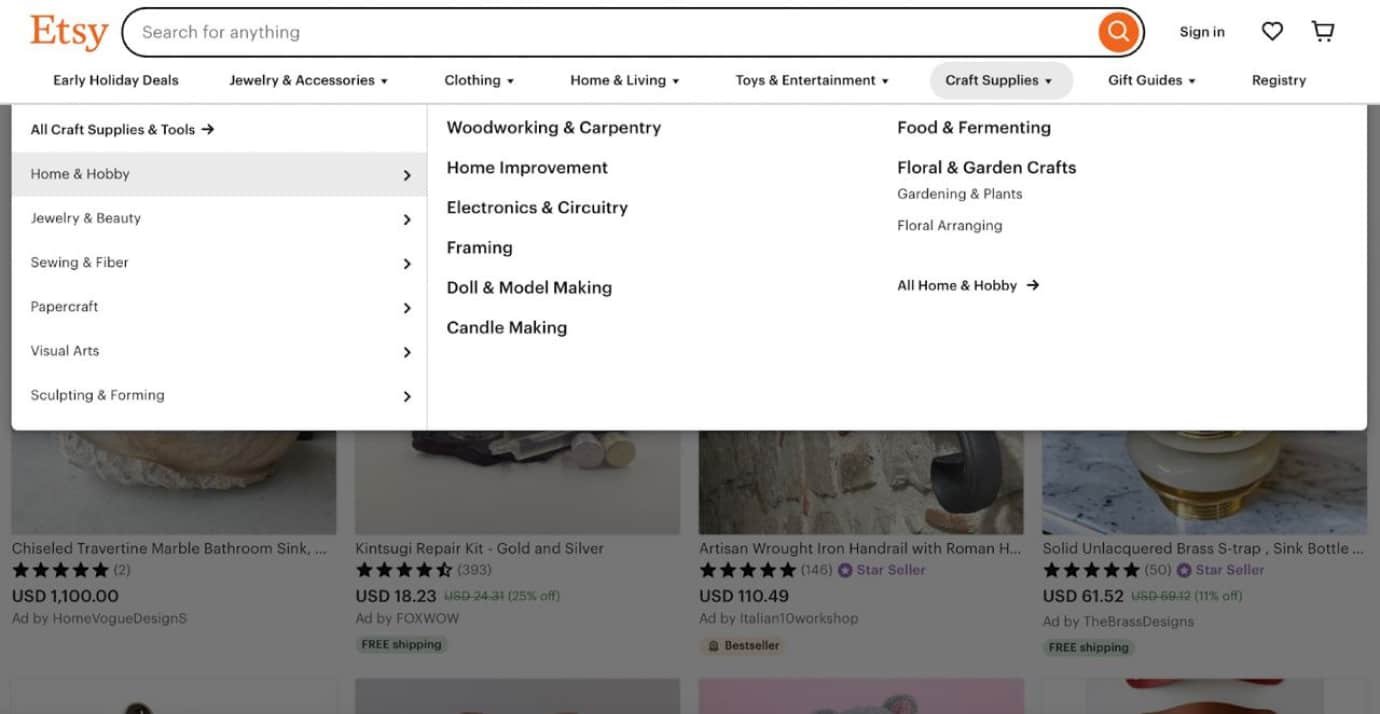
Email or SMS notifications. Enable automated notifications via email or SMS to keep users informed about orders, updates, and essential activities on the platform.
Feedback form. Integrate a feedback system that facilitates communication between buyers and sellers, encouraging reviews and enhancing trust within the marketplace.
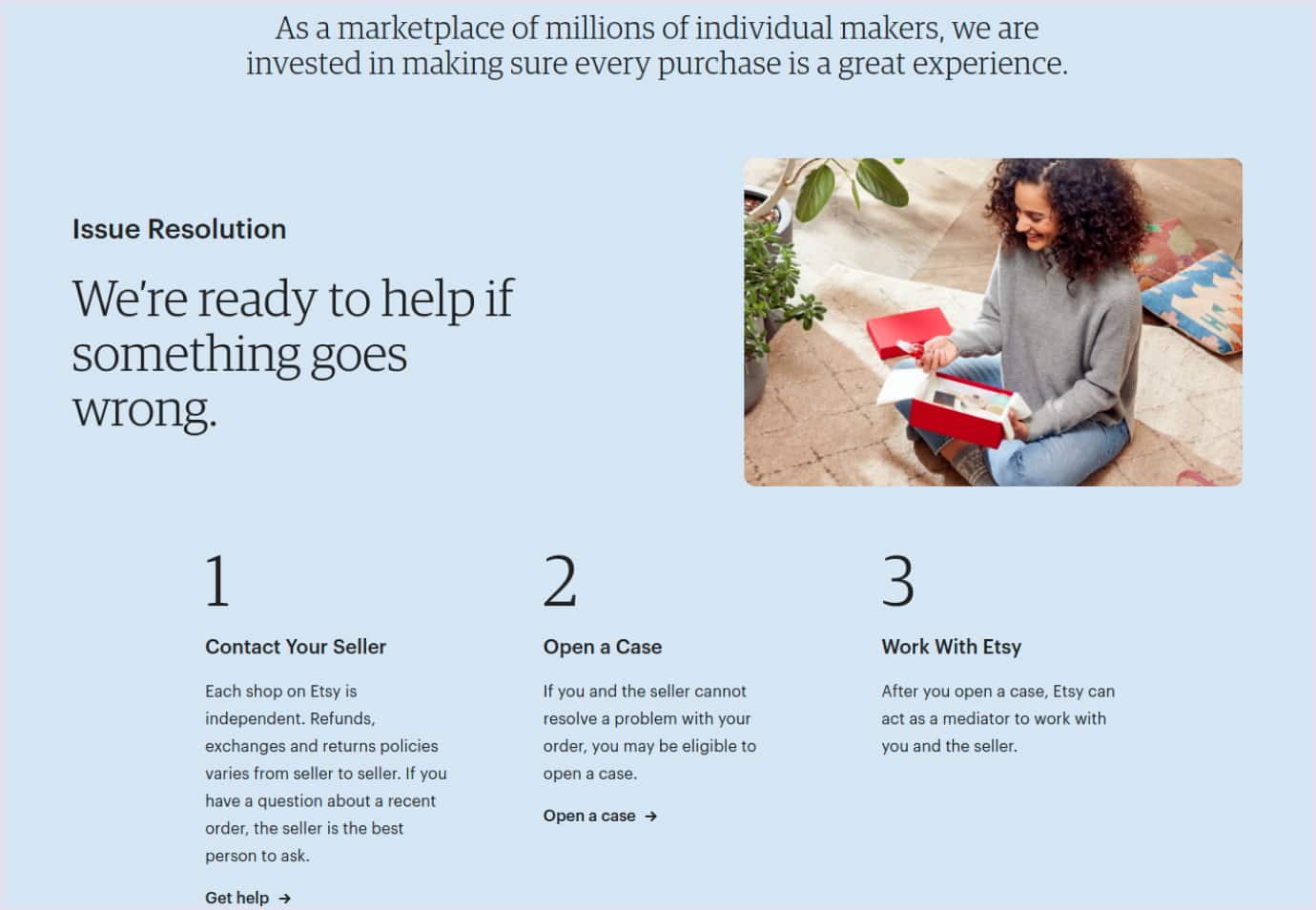
Multiple payments methods. Provide diverse payment options to accommodate user preferences, ensuring secure and convenient transactions.
Shopping cart. Include a functional and intuitive shopping cart feature that allows users to collect and manage their chosen items before purchasing.

Multilingual web layout. Develop a platform with multilingual support to cater to a broader audience, enhancing accessibility for users from different linguistic backgrounds.
Enhanced search filters. Incorporate advanced search filters to assist users in finding specific products efficiently, improving the overall browsing experience.
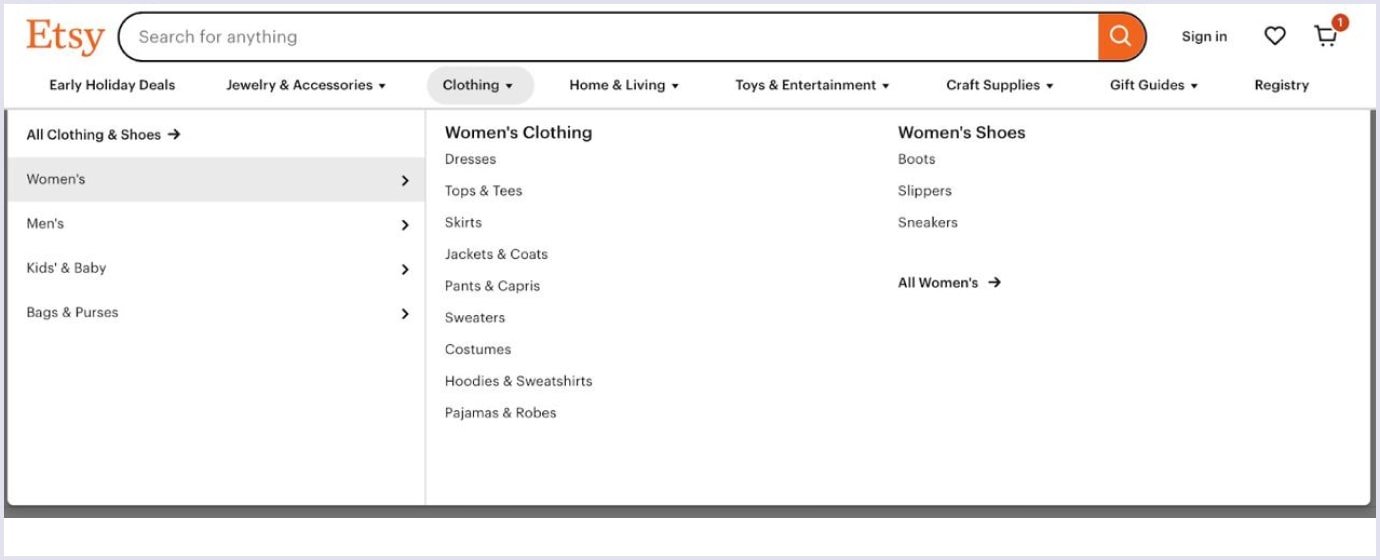
Goods ratings and comparison. Implement a rating system for products and enable users to compare different items, aiding them in making informed purchasing decisions.
Step 5. Pick a design that works
To create the right design for your marketplace software, similar to Etsy's website design, it is important to look at your site from the users’ point of view. We will try to answer the question about how to create a website like Etsy, and share some rules that help you create an excellent user experience (UX).
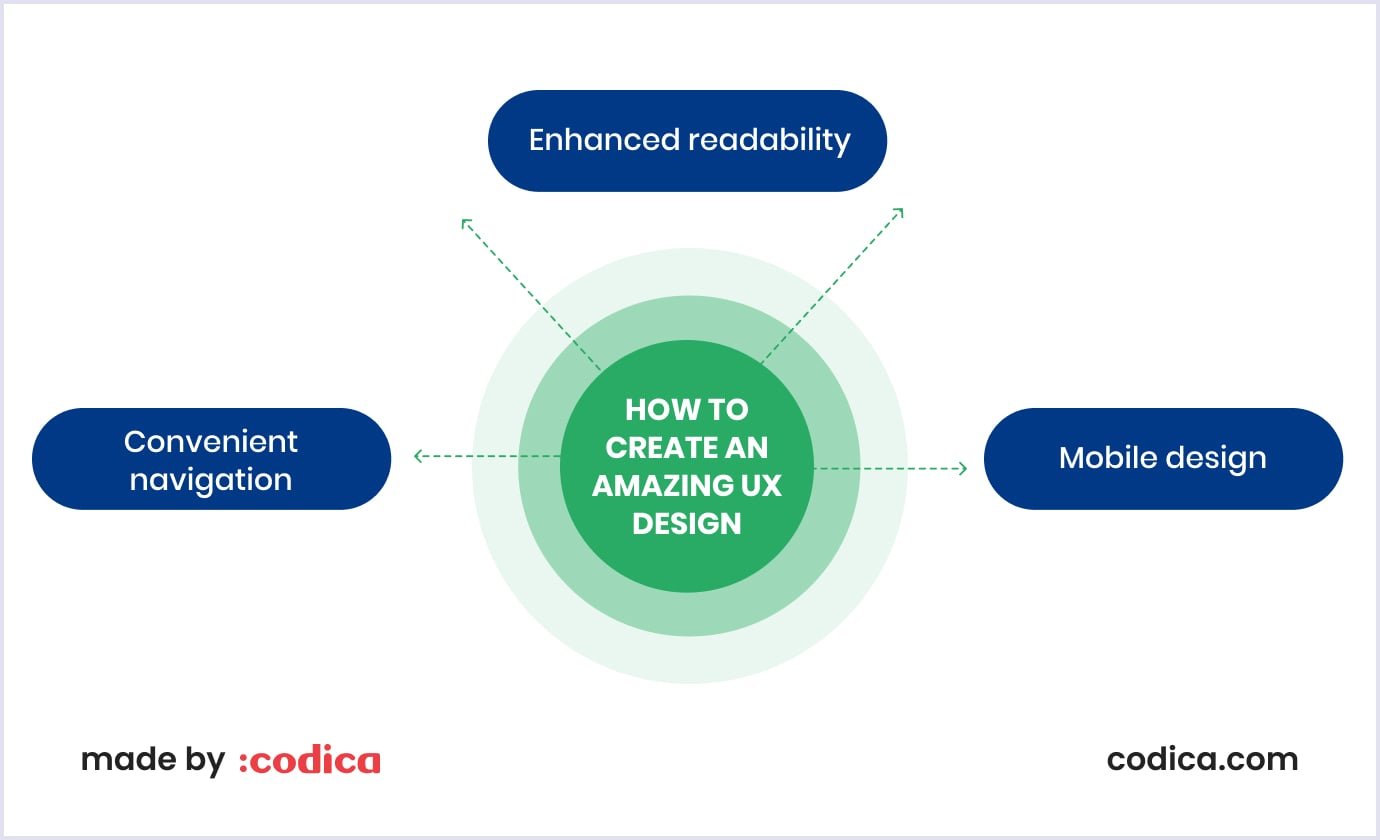
Convenient navigation. Your site’s interface should be understandable and straightforward. Furthermore, users should reach their goals with a minimum number of actions. It is crucial to develop the app’s blueprint in such a way as to make it clear for users and reduce their operational actions. Surely, the best way to do it is to hire a qualified UI/UX design services company.
Enhanced readability. We recommend you use one font in the design, a maximum of two: one for headers and one for text. Also, make the font size comfortable for reading.
Mobile design. So, it is essential to understand that modern business needs an adaptive design for tablets and mobiles. It is a must-have because people have been using mobile devices for a long time.
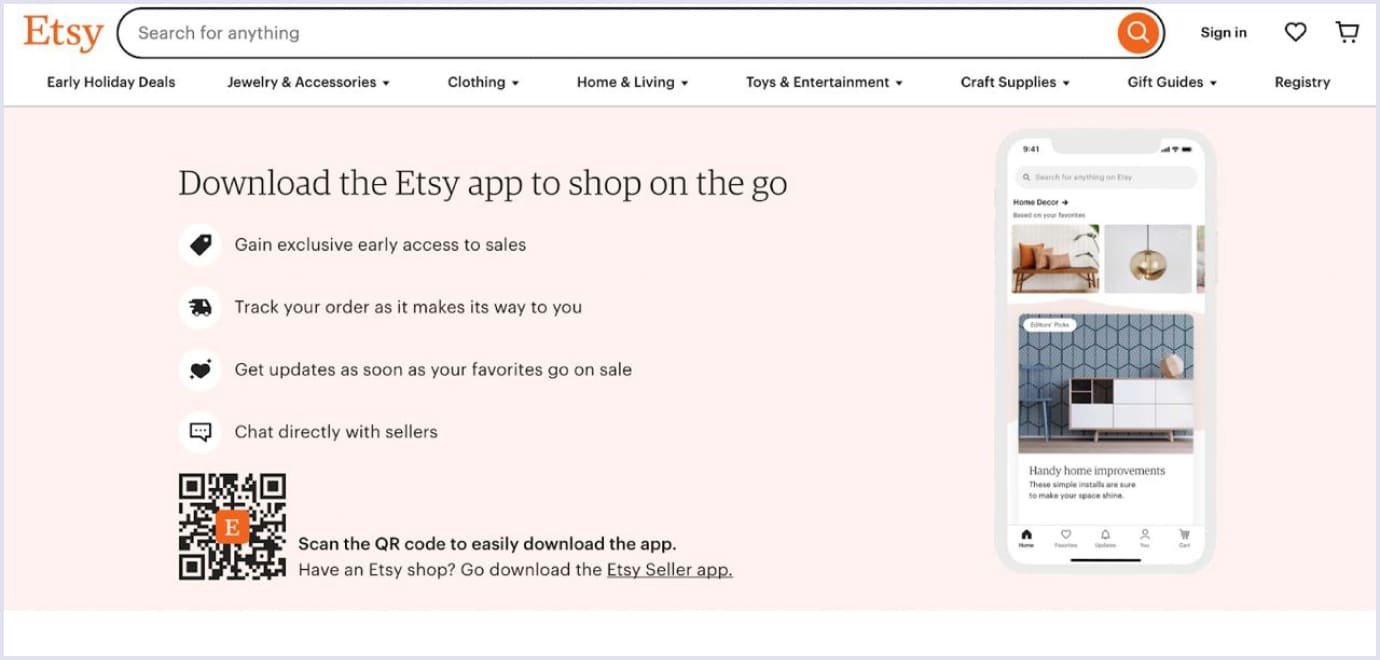
At Codica, we offer cross-platform mobile app development services tailored to our customers' needs.
Etsy, a leading online marketplace, is developed using React Native, and this choice carries several advantages that make it a recommended platform for building cross-platform applications.
React Native, as used by Etsy and many other prominent brands, offers the following benefits:
- Code reusability: React Native allows developers to write code once and deploy it across multiple platforms, such as iOS and Android. This results in significant time and cost savings compared to building separate native apps.
- Faster development: Using a single codebase for both platforms accelerates the development process. Updates and feature additions can be implemented more swiftly, reducing time-to-market.
- Native performance: React Native provides near-native performance, as it compiles to native code. This means your application will have a responsive and smooth user experience.
- Rich ecosystem: React Native has a vast ecosystem of open-source libraries and pre-built components that can be integrated into your app, reducing development effort and enhancing functionality.
- Community support: It benefits from a large and active developer community, ensuring ongoing support, regular updates, and a wealth of resources to aid development.
- Cost-effectiveness: Building a cross-platform app with React Native is generally more cost-effective than maintaining separate native apps for each platform.
In summary, developing your cross-platform mobile application using React Native, as Etsy has done, is a highly recommended approach by Codica specialists.
You may also like: 5 Major Principles for a User-Friendly Website You Need to Know
Step 6. Choose a development approach
If you are looking for how to create an online marketplace like Etsy, you can use a marketplace builder or order custom web development.
Here are some insights to help you choose the right development approach:
Marketplace builder
Using a marketplace builder is convenient and cost-effective for those looking to launch their platform swiftly with minimal technical expertise. These platforms offer pre-built templates and features that can be customized to some extent to suit your requirements. They are ideal with a limited budget and a relatively straightforward concept.
- Pros: Quick setup, cost-effective, user-friendly.
- Cons: Limited flexibility, may not accommodate complex or unique features.
Sharetribe is one such marketplace builder that specializes in creating online marketplaces. It provides a user-friendly interface and pre-designed templates that can be tailored to your specific needs. Sharetribe is particularly suitable for businesses setting up peer-to-peer marketplaces, service booking platforms, or rental marketplaces. It offers features for managing listings, payments, and user interactions, making it a popular choice for entrepreneurs aiming to enter the sharing economy.

Shopify is another well-known marketplace builder that caters not only to marketplaces but also to ecommerce businesses. It provides a robust and highly customizable platform for launching your online marketplace. Shopify's extensive ecosystem offers various apps and integrations, allowing you to add multiple functionalities to your marketplace. Whether selling products, services, or both, Shopify can be a universal choice for creating your online marketplace.
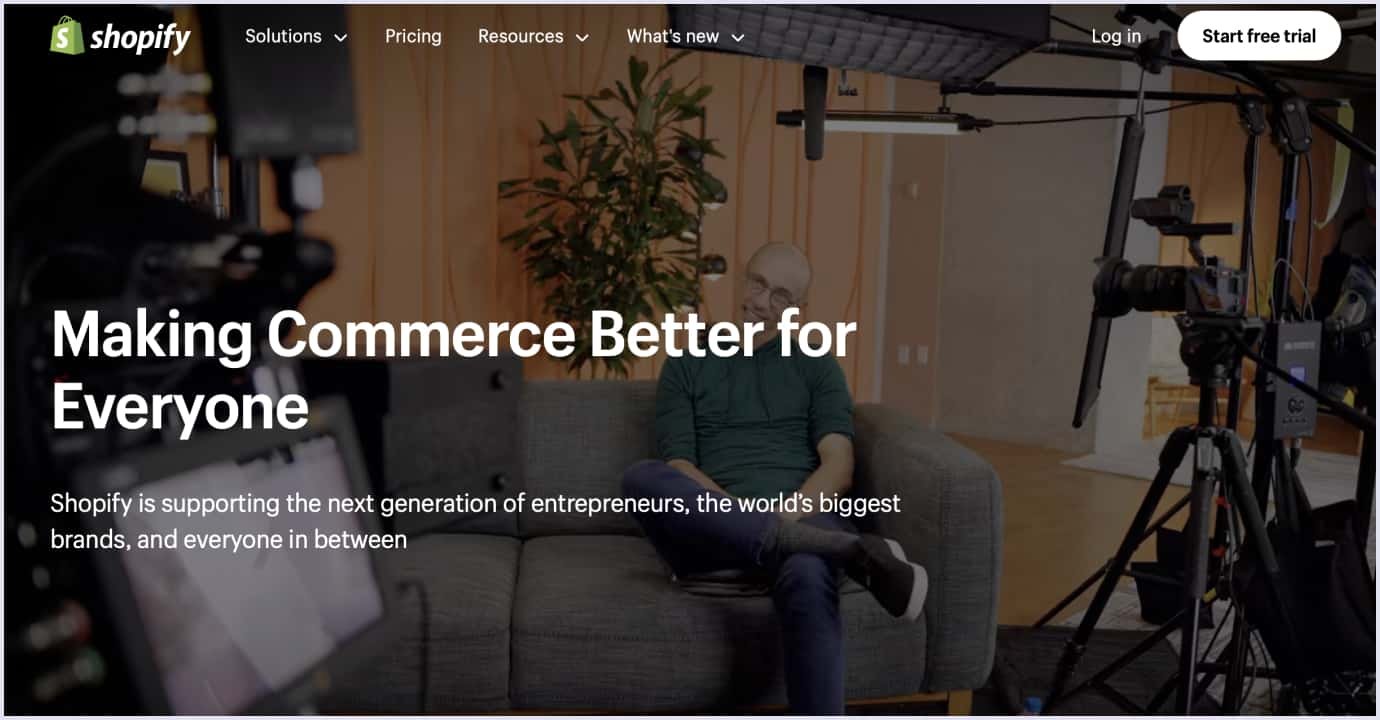
Custom web development
Opting for custom software development services provides the highest level of flexibility and allows you to bring your unique vision to life. It's the choice when your marketplace demands specific and complex features or a distinctive user experience. While it may require a more substantial investment, it can lead to a more tailored and competitive platform.
- Pros: Complete customization, scalability, and unique features.
- Cons: Higher upfront cost, longer development timeline.
The choice between these approaches depends on several key factors:
- Your concept and feature requirements: Consider the complexity of your idea and the features your marketplace requires. If your concept is relatively simple and aligns well with existing marketplace builder templates, this option may suffice. However, if your concept is unexplored or requires advanced functionalities, custom development offers a customized solution.
- Budget considerations: Evaluate the financial resources at your disposal. Marketplace builders are generally more cost-effective initially, making them suitable for startups with limited budgets. Custom development, while potentially more expensive, offers long-term value and a unique competitive edge.
- Time constraints: Your project's timeline is a critical factor. Marketplace builders are known for their speedy setup, which can be valuable if you need to launch quickly. Custom development, on the other hand, may require more time due to the detailed development process.
By focusing on these criteria, you will narrow down your search and increase your chances of finding the right technology partner.
At Codica, we are proud of our successfully completed projects. For example, we helped our client create a personalized and attractive web solution for the PlanMyKids online service marketplace. The task was to create a user-friendly web application that helps busy parents plan and book activities for their kids. Recognizing the importance of providing parents with a seamless and convenient experience, our dedicated professionals created a solution to address this unique demand.
This platform simplifies the process of booking kids' activities. Parents fill out a questionnaire, and the system suggests relevant activities based on their children's interests. Program specialists review and create an itinerary for parents.
To enhance the mobile user experience, a fast-loading progressive web application was developed, allowing seamless access on both Android and iOS devices without the need for a dedicated app. Also, integration with Zoho Forms facilitates the creation of mobile-friendly online forms, ensuring a simple and efficient questionnaire and sign-up process for parents, even on smartphones.
Thanks to Codica’s team of professionals, our client received a convenient and user-oriented MVP of the online marketplace. With our MVP web development services, our client can continue to build and expand their platform, ensuring that it remains a valuable resource for parents seeking to enrich their children's lives with engaging experiences.
Our success with PlanMyKids is just one example of how Codica is dedicated to partnering with our clients to bring their innovative ideas to life. We look forward to taking on new challenges and delivering even more success stories as we continue to work with clients who share our passion for excellence and innovation.
Below is the client quote of David Watkins, founder of PlayMyKids.
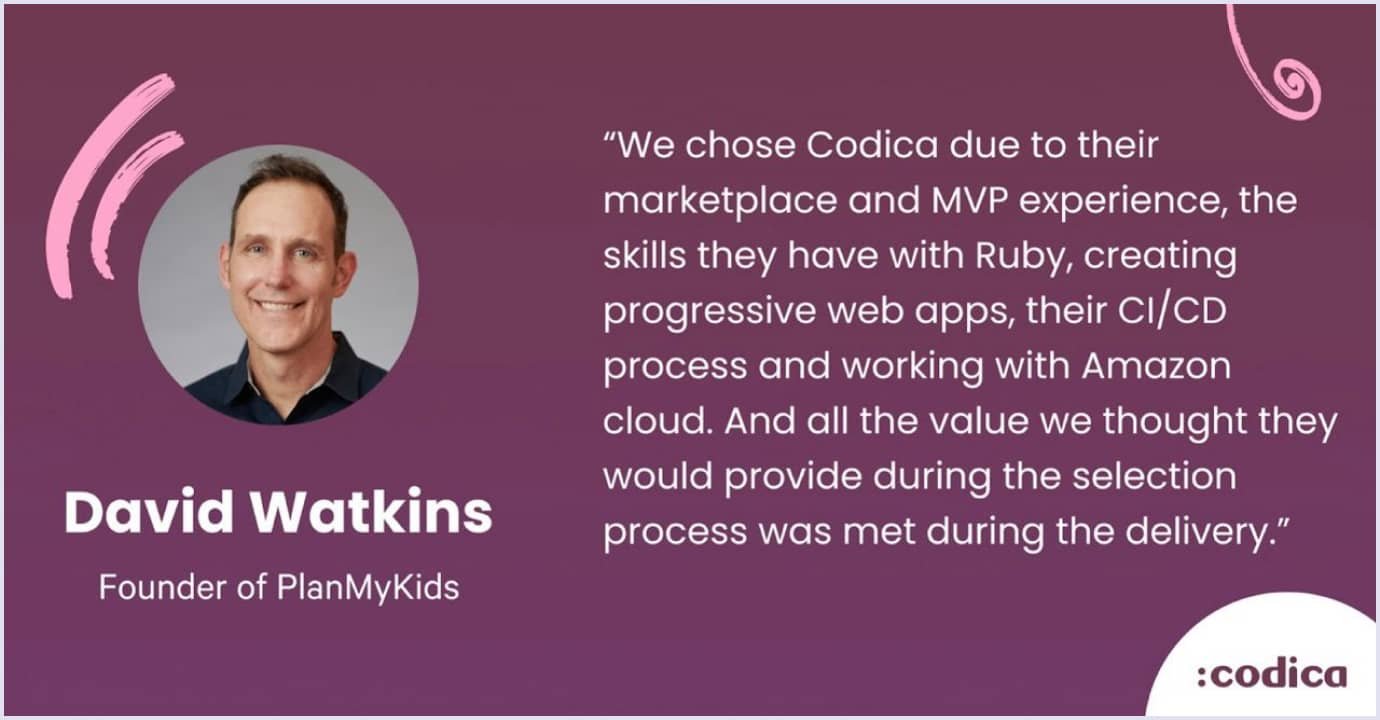
Selecting the right tech stack for building an online marketplace like Etsy
Notably, choosing the technology stack can affect the development budget, time, web application quality, and scalability of your own marketplace. To build a scalable, secure, and reliable platform like Etsy, we recommend you to use the right technology stack.
Let's take a look at the two main parts of the Etsy tech stack: frontend (client-side) and backend (server-side). Each of the two parts implements specific functions and comprises a relevant set of tools.
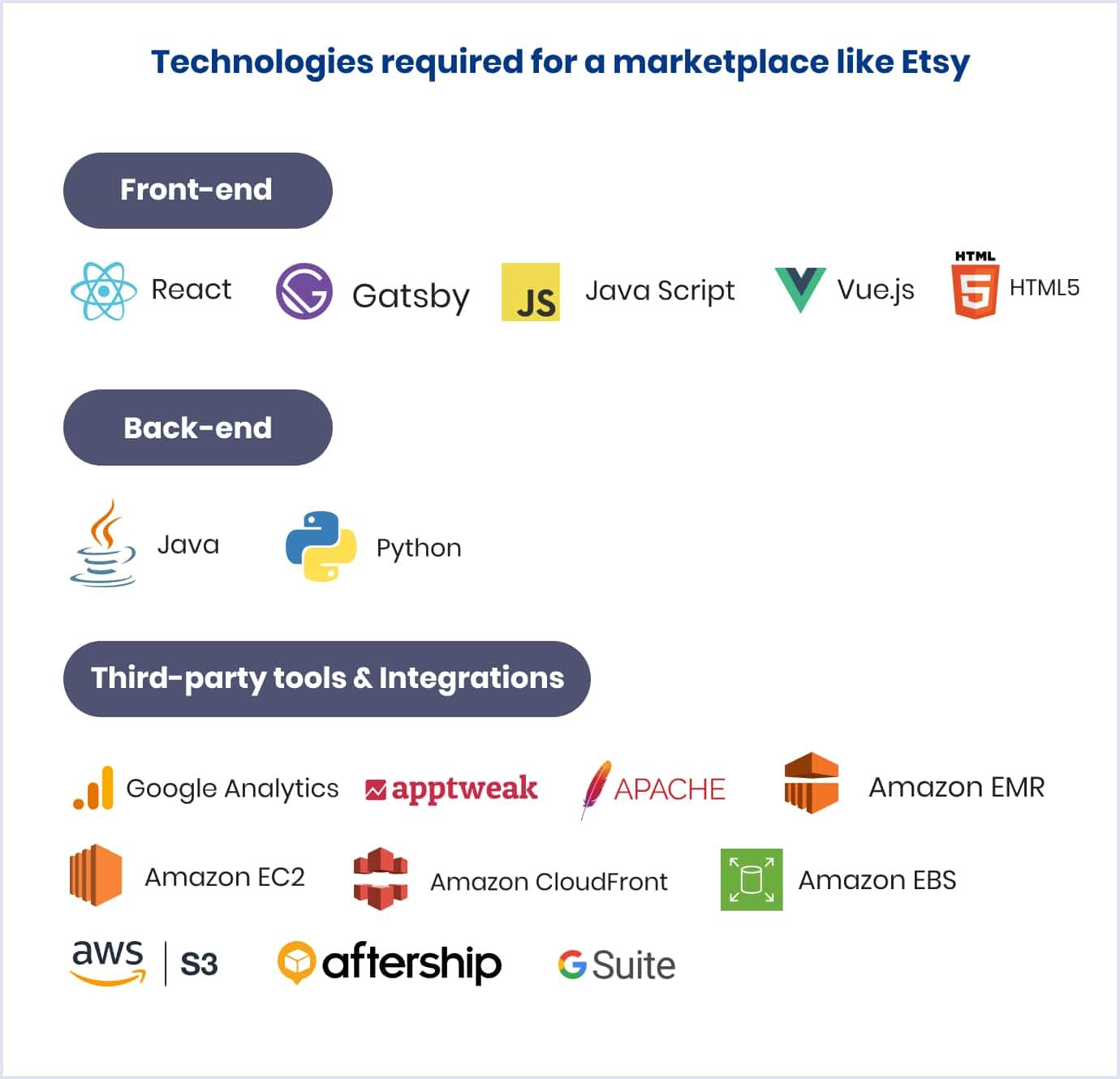
Frontend or client-side
React is the choice of the Etsy marketplace for its client-side. Nevertheless, you can choose any other technology stack for your website development. At Codica, we prefer React, JavaScript, Vue.js, Gatsby, and HTML5 for building web projects.
Backend or server-side
As for the server-side, Etsy uses Python and Java programming languages. Also, you can choose Ruby on Rails and Ruby for the Etsy-like marketplace development.
Third-party tools and integrations
There are utilities that Etsy uses, such as Google Analytics, AfterShip, AppThwack.
Moreover, it uses such apps as Apache HTTP Server, Amazon S3, Amazon EC2, Amazon CloudFront, Amazon EBS, Amazon EMR, and business tool G Suite.
Selecting the advanced tech stack for your marketplace, like Etsy, is a critical decision that can significantly impact your platform's performance, scalability, and overall success. Carefully assess your project's requirements, your team's expertise, and the specific needs of your marketplace to make informed choices at each stage of development.

Estimating the cost of developing a website similar to Etsy
Now, we have come to an interesting question about the cost of Etsy's website.
To put it short, the main aspects that have an impact on the final price are:
- The development approach: out-of-the-box solution vs. custom web development;
- The required functionality you want to implement.
Obviously, the ready solution costs less than custom development. However, for complex projects like building Etsy’s clone, we recommend you choose an experienced agency and build a custom website.
Below, you can see a table that shows the rough estimate of the total cost to build a marketplace like Etsy. To receive the final prices, we used the average rate of Eastern European development agencies, which is $50 per hour.
| Cost of MVP development for marketplaces similar to Etsy | ||
| Features | Time, hours | Cost ($50/h) |
| Design | ||
| UX Development | 56 | $2,800 |
| UI Development | 96 | $4,800 |
| Architecture | ||
| Project setup | 36 | $1,800 |
| DB structure | 24 | $1,200 |
| Integrations | ||
| Payment (Stripe or PayPal) | 80 | $4,000 |
| Shipment (Shippo) | 80 | $4,000 |
| Main functionality | ||
| Authorization and security | 56 | $2,800 |
| User profiles | 32 | $1,600 |
| Homepage | 64 | $3,200 |
| Search and filters | 72 | $3,600 |
| Product page | 32 | $1,600 |
| Reviews & Ratings | 48 | $2,400 |
| Shopping cart | 84 | $4,200 |
| Vendor panel | 92 | $4,600 |
| Admin panel | 72 | $3,600 |
| Non development activity | ||
| Project management | 72 | $3,600 |
| Quality assurance | 92 | $4,600 |
| Code review | 36 | $1,800 |
| Total | 1124 | $56,200 |
So, how much does it cost to create a website like Etsy? The approximate estimate is $56,200. Please consider that the final price will depend on your web development partner.
Undoubtedly, the creators of Etsy invested significant costs in their web development. So, it is essential to understand that building a marketplace like Etsy will not cost a small amount.
Related reading: How Much Does It Cost to Build a Website in 2023?
Codica’s role in delivering your Etsy-inspired marketplace
Since 2015, the Codica team has been delivering high-quality and robust ecommerce solutions in different domains. In particular, we will help you build an online marketplace like Etsy. Over the years, we have successfully launched many ecommerce platforms that help our customers grow their online marketplace business, receive high traffic, and increase sales.
What truly sets us apart is our ability to tailor solutions that are functional and aligned with your marketplace's unique needs. Your business project will benefit from our skills in delivering user-centric, aesthetically appealing solutions and equipped with the latest technology trends. Our team understands the difficulties of creating a marketplace that stands out in a crowded digital landscape, and we are ready to guide you through this development journey.
The foundation of any booming marketplace lies in a well-thought-out strategy, robust architecture, and an intuitive user experience. We don't just build platforms; we co-create success stories with our clients, understanding their vision and translating it into a digital reality.
We are committed to delivering a project and fostering a growth and transformation partnership. Your marketplace journey will be marked by our unwavering support and a team that genuinely invests in your success.
Let's check some of the successful projects our specialists have delivered.
Custom ecommerce solution
This project is a multi-vendor marketplace platform with no analogs in the UK or Europe. It provides many options to users, allowing them to offer products and services within one platform between its B2C (business-to-consumer) and C2C (consumer-to-consumer) parts.
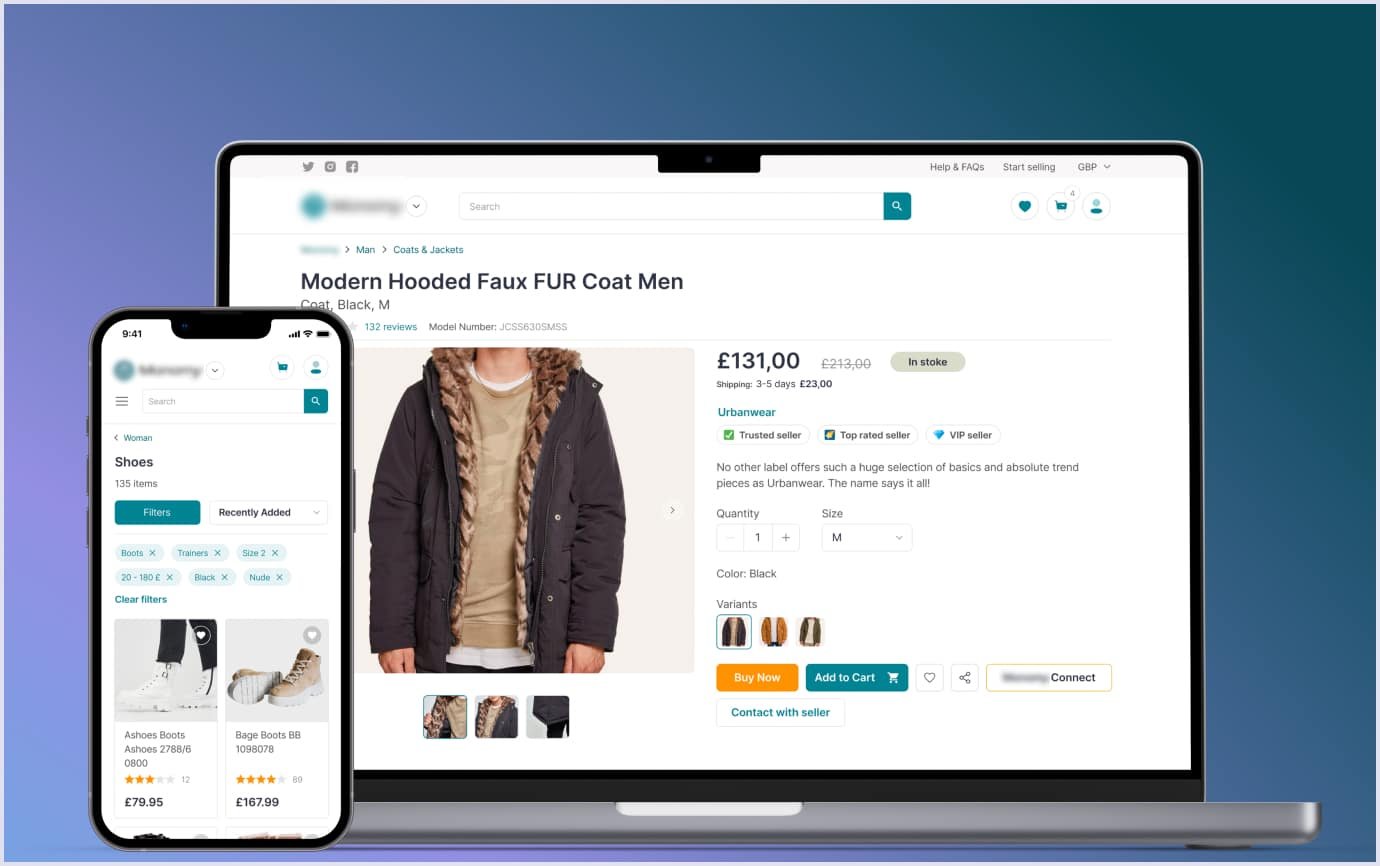
There are some of the results of our collaboration with this big client:
- Checked the marketplace business idea with real users with the help of an MVP platform and improved the custom ecommerce solution based on the collected data.
- Developed the appealing design of a custom ecommerce solution that is inviting, eye-pleasing, and intuitive.
- Performed competent SEO of the marketplace to make the custom multi-vendor website receive more visitors.
- Provided an option for users to find services by choosing a location radius owing to the geolocation and map integration.
Also, we offer you another vivid example of an online marketplace we have developed.
Online marketplace for boats in Australia
Trade A Boat is Australia's favorite online platform to sell and buy new/used boats and marine equipment. Our customer's main request was to refine the existing solution and create a new website to reach better business results. The main requirement also was to make this popular boat-selling website in Australia mobile-friendly and fresh-looking.
There is the result of our collaboration with the client:
- Delivered a progressive web application, which provides an improved user experience.
- Conducted complex SEO to make the website noticeable on the web and user-friendly.
- Integrated third-party services that allow receiving advertisements from dealers throughout Australia.
- Created user-friendly interface - updated product card, added category icons to increase readability, highlight important content, and improve UX design.
Thus, our expert team worked thoroughly to implement all the required functionality for these ecommerce marketplaces. As a result, our clients got a fast-loading, fully functional platforms with a smooth UX, and advanced search filters, thanks to ours:
- Product discovery services;
- UI/UX design services;
- Ecommerce marketplace development services;
- DevOps services;
- Quality assurance services.
We are always glad to share our successful results with our readers. Find a minute to look at our portfolio. Each project in our portfolio is a testament to our commitment to excellence, innovation, and a client-centric approach.
Read also: 14 Top Ways To Attract Sellers and Buyers to Your P2P Marketplace
Final thoughts
A website like Etsy is an exciting experience that requires careful planning, dedication, and a commitment to fostering a vibrant online marketplace. This step-by-step guide has illustrated the process's key considerations and essential phases, from ideation to launch.
So, we have discussed all the points you should consider before building a platform like Etsy. We got acquainted with Etsy's success story and discovered this marketplace business model and monetization strategies. Moreover, you get a picture of how to create a site like Etsy. Now, you have this essential information to help you launch a booming P2P marketplace.
If you are wondering how to create a website like Etsy but don't know where to start, our full-cycle software development team will gladly assist. Contact us, and we will create a high-quality, user-friendly, and thriving ecommerce marketplace for you.

